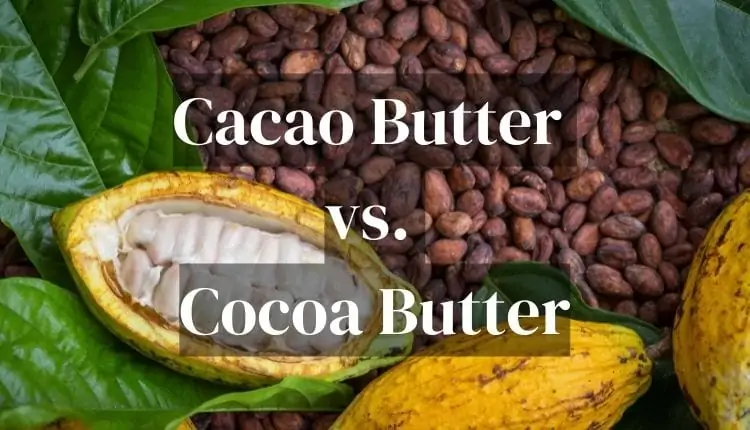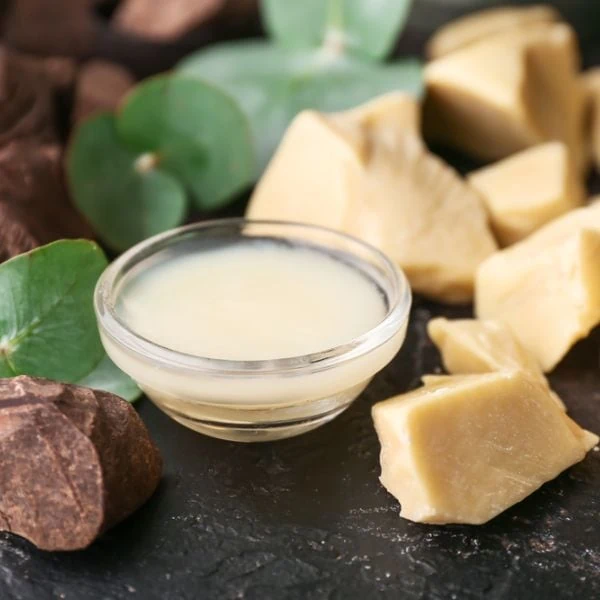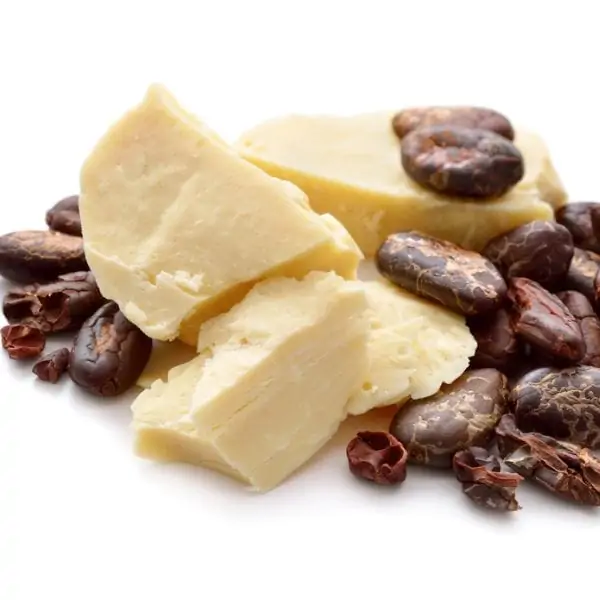Cacao and cocoa are two words used interchangeably. You may wonder if it’s worth using them for different purposes because they seem to be the same product.
While it’s true that they come from the same source, it’s the processing that makes them different. They are processed at different temperatures and have different flavors. You’ll have to look a little hard for the one you want because even some companies use the wrong name.
With the right product, you can have a healthier diet and enjoy all your favorite desserts with a bit of extra protein. So, let’s get straight into the differences.

Bottom Line Upfront
Cacao and cocoa butter are the same until it comes to the processing part. Cacao is the unrefined form of cocoa butter, and it has many benefits, which make it the better option.
Main Differences Between Cacao Butter And Cocoa Butter
- Cacao butter is raw, whereas cocoa butter is processed at a higher temperature.
- Cacao butter is full of fiber and protein, whereas cocoa butter has fewer benefits.
- Cacao butter is rich in antioxidants, whereas cocoa butter has less antioxidant capacity.
- Cacao butter is slightly bitter, whereas cocoa butter is sweeter.
- Cacao butter has a rich color and aroma, whereas cocoa butter is stripped of these.
- Cacao butter helps prevent and reduce stretch marks, whereas cocoa butter doesn’t give the same results.
Key Features Of Cacao Butter
Cacao butter is raw cocoa butter. It is processed at a lower temperature as compared to cocoa butter. Here are some key features of cacao butter:
- It is produced at 46 degrees Celsius. The temperature never exceeds this number.
- There’s little exposure to low temperatures, so the nutrient density and antioxidant capacity remain the same.
- Cacao butter is on the bitter side.
- Cacao butter or raw cocoa butter contains different fatty acids like Lauric acid, Stearic acid, Palmitic acid, Myristic acid, and Arachidic acid.
Pros/Cons Of Cacao Butter

- Since it’s unrefined, you’ll get richer texture, color, and flavor in your recipes.
- Antioxidants in unrefined cocoa butter include palmitic, stearic, and oleic acids. These fatty acids allow the neutralization of the free radicals in our bodies. This, in turn, reduces wrinkles and age marks.
- It can be used as a moisturizer. It’ll absorb right into your skin and keep it hydrated for long periods.
- The present acids improve skin elasticity and prevent stretch marks.
- It’s a good addition to keto-friendly diets.
- Overall, cacao butter is a healthier option compared to cocoa butter.
- Since cacao butter is raw, it has no artificial ingredients or preservatives. That means that the quality of the butter is never compromised, and this will improve the taste of your dishes.
- Sometimes, cocoa butter is deodorized. However, cacao butter is usually unscented so that you can get the chocolate scent of cocoa butter with all its natural characteristics.
- It can reduce frizziness and leave hair shiny and silky.
- Raw cocoa butter has also proved to be effective against infections, stretch marks, and rashes. It soothes the affected area of the skin and helps with skin diseases such as dermatitis and eczema.
- Cacao contains vitamin D, which promotes the absorption of calcium in the gut.
- Since it is more bitter than cocoa butter, you may take some time adjusting to the way it tastes. However, if you’re using it in recipes, you shouldn’t have trouble altering the sugar levels to your liking. Plus, if you’re using this as a part of your skincare routine, the bitterness won’t be a problem!
- Since this butter contains caffeine, over-consumption can lead to insomnia and headaches.
Key Features Of Cocoa Butter
Cocoa butter also comes from the cocoa bean, but it has significantly fewer benefits than cacao butter. Here are some key features:
- Cocoa butter is processed at a higher temperature than cacao butter.
- It tastes sweeter and doesn’t have the same bitter notes found in its cacao alternative.
Pros/Cons of Cocoa Butter

- Most of cocoa butter’s benefits are the same as cacao butter.
- Cocoa butter is good at hydrating the skin and getting rid of stretch marks.
- It’s also effective when it comes to skin diseases or hair problems such as dry, frizzy hair.
- It has added preservatives that can reduce heart health and increase the risk of cancer. It also reduces the quality of the product.
- Cocoa butter tones down the texture and flavor of raw cacao.
- It also has fewer antioxidants than cacao butter.
- Cocoa butter usually has added scents to it. It takes away the original chocolate aroma.
- Since cocoa butter is refined, the added chemicals can cause the skin to get irritated.
Other Alternatives To Consider
If you don’t prefer using either of these, here are some great alternatives you can consider:
Shea Butter
Just like cocoa and cacao butter, shea butter is a plant-based fat that moisturizes dry skin. All three types melt into your skin and keep it hydrated.
The key difference is that we get shea butter for the nuts of a shea tree, whereas cocoa and cacao butter comes from cocoa beans. Here are some differences that can help you decide which one you want to use:
- Shea butter gives off a smokey scent, unlike cocoa which has a chocolatey aroma.
- This type of butter evens out skin tone and reduces the damage caused by the drying of the skin.
- If you have acne-prone skin, shea butter will be a better option for you. Cocoa butter is thick and can sometimes worsen your acne by clogging your pores.
- Unrefined shea butter is better at reducing stretch marks than cocoa butter.
- You can even use shea butter in your recipes. The presence of stearic acid can help lower cholesterol levels.
- This butter can treat diarrhea.
- The only downside is that while cocoa and cacao butter can last for up to 5 years, shea butter has a shelf life of only 2 years.
Kokum Butter
Kokum butter comes from the kokum tree, typically found in the tropical regions of India. Here are some key features and differences of this alternative:
- Kokum butter, just like shea butter, can help manage your cholesterol levels due to stearic acid.
- This butter has a hard texture and can be used as a moisturizer.
- Usually, you’ll find kokum butter mixed with other types of butter or oil to give it a thinner consistency and a smoother texture.
- Unlike cocoa butter, kokum butter is very light and won’t clog your pores. It’ll also not leave you with a greasy feeling once you’ve applied it to your skin.
- It can also bring down skin inflammation caused by burns or cuts.
- Unlike shea butter, kokum butter doesn’t treat acne too well. It may show you good results, but that depends on the cause of your acne.
- Another significant difference between cocoa/cacao butter and kokum is that the latter has no scent. This is the perfect alternative for those who aren’t fond of skin care products with heavy aromas.
- As for the downsides, kokum butter is much more challenging to get as it’s not as widely available.
- It is more costly than cocoa and shea butter.
- Since it has a hard structure, you can’t mix it with other products or ingredients as easily.
Coconut Butter Or Oil
Coconut oil is made by using the fat content in the coconut, whereas coconut butter is created by blending dried coconut until it turns into a liquid. These are some notable features and differences:
- Compared to cocoa butter, coconut oil takes a more liquid form once melted. Instead of melting it, you can cream the oil if you want a thicker consistency.
- Even though the flavors aren’t identical, you can still sense the nutty, sweet notes in both cocoa butter and coconut oil.
- Coconut butter is closer in texture to cocoa butter than coconut oil. This feature makes it a more suitable substitute.
- This butter alternative is made from the whole coconut and has more fiber and protein.
- However, coconut butter is much stronger in taste than coconut oil, so it may overpower your recipe. You can still add other ingredients such as chocolate or cocoa powder to your dish to get the delicious flavors of cocoa butter.
FAQs
Is cacao butter and cocoa butter the same thing?
Cacao and cocoa butter comes from the same cocoa beans. During the processing, cacao butter is given less heat than cocoa butter.
So, while they are the same, cacao butter is the raw form of cocoa butter. It has many benefits over the refined form.
What do you use cacao butter for?
Cacao butter can make a great part of your skincare routine. It can moisturize your skin, reduce stretch marks and wrinkles and help bring down inflammation from any burns or cuts.
It can also be used in your hair for smoother and silkier results. You can use cacao butter in recipes. It has a rich chocolate scent and flavor that can take your desserts to another level.
Plus, fiber and protein make cacao better than regular butter.
What can I substitute for cacao butter?
Here is a list of alternatives you can use:
- Shea butter
- Kokum butter
- Coconut oil
- Coconut butter
- Cocoa powder
- Cocoa paste
- Butter
These all can work, but the best alternatives are shea butter, kokum butter, coconut oil, and coconut butter.
Conclusion
You can use cocoa butter and cacao butter interchangeably, but cacao butter has benefits over the other one, making it the superior option.
There are no added preservatives, flavors, scents, or other chemicals that alter cacao butter, which makes it a high-quality ingredient and skincare product. It’s true that cocoa butter shares many of the same properties, but with these benefits, there’s no way you can ever switch to cocoa butter!










Adeena is a freelance content writer and cooking enthusiast from Pakistan. She is currently a business student, and when she wants a break from her studies, writing on her favorite topics and cooking yummy dishes are her favorite things to do.